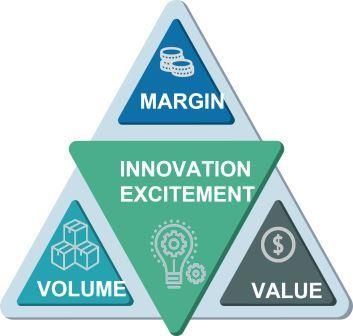
🎓 Definition
The category strategy defines the Role in which the Retailer wants a category to play - or how it wants its Customers to perceive it. The available strategies will therefore be:
- Reinforce a category in its role.
- Shift a category from one role to another.
A Category can be assigned a role strategically, and the analysis of its performance can show that its effective role is different. For each role, the strategy and tactics are different. It is critical for the supplier to know which role its category effectively is in each store format, Region, or Cluster. The supplier will then be able to develop a business plan that supports that Strategy.
🧪 Example of Category Performance Analysis
Driving and monitoring performances of your category will include several steps:
- Range Review
- Category Review
- Suppliers Review
- Supplier Preparation
❓What is used for
Category Strategy needs to deliver Innovation and Excitement to Customers around 3 common Retailer Pillars

The Category Strategy strengthens the Retailer's (Brand) Promise to its Customers, it is supported by its Category role and Tactics.
It is important that your Category Strategy is aligned with your Category Role you attempt to fulfill.
How does a retailer determine which role a category effectively plays in each store format, region, or cluster?
Retailers typically determine the effective role of a category through comprehensive performance analysis. This involves evaluating sales data, customer feedback, and market trends specific to each store format, region, or cluster. By conducting range reviews, category reviews, and supplier reviews, retailers can gain insights into how customers perceive and interact with different categories in various settings. This data-driven approach helps retailers identify the most appropriate role for each category to maximize its performance and alignment with customer expectations.
What specific tactics should suppliers employ to support the different roles identified for their categories?
Suppliers should develop tailored business plans that align with the identified roles for their categories. For instance, if a category is meant to reinforce a particular role, suppliers might focus on enhancing product assortment, promoting innovation, and collaborating closely with retailers to create targeted marketing campaigns. On the other hand, if the goal is to shift a category's role, suppliers may need to invest in rebranding, introducing new product lines, or adjusting pricing strategies to meet the desired positioning. The key is to adapt tactics in alignment with the category strategy to effectively support the retailer's objectives and customer perceptions.
Can you provide examples of how a retailer's brand promise is strengthened by aligning the Category Strategy with its designated role?
Certainly, aligning the Category Strategy with its designated role can significantly strengthen a retailer's brand promise. For example, if a retailer's brand promise emphasizes affordability and value, aligning the Category Strategy to reinforce this role might involve promoting cost-effective product options, offering exclusive discounts, and highlighting the savings that customers can enjoy. Conversely, if the brand promise focuses on innovation and premium quality, shifting a category's role could involve introducing cutting-edge products, partnering with high-end suppliers, and creating a more upscale shopping experience. By ensuring consistency between the Category Strategy and the brand promise, retailers can build trust, enhance customer loyalty, and differentiate themselves effectively in the market.
• Category Role
• Category tactics
• Category Management Process
• Supplier Strategy
• Range Review Process